How to escape from the "hares". Instructions for dealing with ultraviolet
- Tutorial
Once in the distant school years, I had the idea to do auto-restoration, since my father already had almost rotted (but with an excellent engine) AZLK Moskvich-408 . First of all, of course, it was decided to change the thresholds and strengthen the frame with a metal channel. The fastest way - naturally welding, the benefit of his father and a homemade machine on the W-shaped plates was. I found the electrodes and, in principle, pretty well welded pieces of metal. Satisfied with my work I fell asleep, thinking that I would be welding in the morning. And in the morning I woke up and realized that I was “blind”, and my father congratulated “on the first hare caught”. To understand what the conversation is about - follow the cut.

In the photo, by the way, damans or "rock hares" , but then everything ended more or less safely, familiar men recalled their similar experiences with the welding business (see ophthalmia ), mother felt sorry for and buried Levomycetin vs Lidocaine in the eyes . And I was thinking about what blind people are like to read articles and work with a computer, and I’ve already wondered about a draft of an article on this topic. But the young body is recovering quickly and by the end of the second day the effects of the conjunctival burn disappeared and the head was again occupied with some everyday thoughts.
The second time I ran into "hares" when I listened to the stories of one of the old mountain tourists about snow blindness. Dedok as an example, he compared what they say "mountain blindness is the same thing as welding catch hares" (yes, the very ones). It was then that I finally got around to deal with such a rather dangerous eye disease, like electrophthalmia and find out for myself that “ultraviolet” is far from being only a “source of vitamin D” ( not all yogurts are equally useful ).
Several times in the electrotechnical department of our central department store TsUM personally heard from people questions to sellers "and you do not have UV lamps ?!", "But where to buy a UV lamp?" etc. As it turned out later, people need ultraviolet light lamps for completely different reasons - someone to “treat the parrot” (???), someone wanted to “watch the minerals”, there were those who tried to start the UV treatment of water or determine skin diseases Wood's lamp.
And this means that people quite actively use ultraviolet, adding to themselves bonuses to solar radiation. Moreover, it is natural not to use any protection at all. After all, the Internet says "do not be afraid, the glass will delay." And these poor fellows are sitting in ordinary glasses. Using the fact that Habr is indexed well, I decided to write a small tutorial on the basics of security ( and at the same time encourage my pharmaceutical diploma, otherwise I’ll write about routers, even lab technicians laugh ). Since he was looking for information on the protection against UV and did not really find anything (he went to the mountains with glasses from some Soviet device).
And at the request of workers, the interpretation ( from here ):
“Caught Bunnies” is a slang expression of welders, meaning burns of the retina and the mucous membrane of the eye due to exposure to bright light when working with electrodes during welding.
A few words about the classification of the ultraviolet and its sources
Just in case for those who knew and forgot, a little bit of Wikipedia :
Ultraviolet radiation (ultraviolet rays, UV radiation) - electromagnetic radiation occupying the spectral range between visible and X-ray radiation. The wavelengths of UV radiation are in the range from 10 to 400 nm (7.5 · 10 14 —3 · 10 16 Hz). The term is derived from lat. ultra - over, outside and purple (violet). In colloquial speech can also be used the name "ultraviolet"
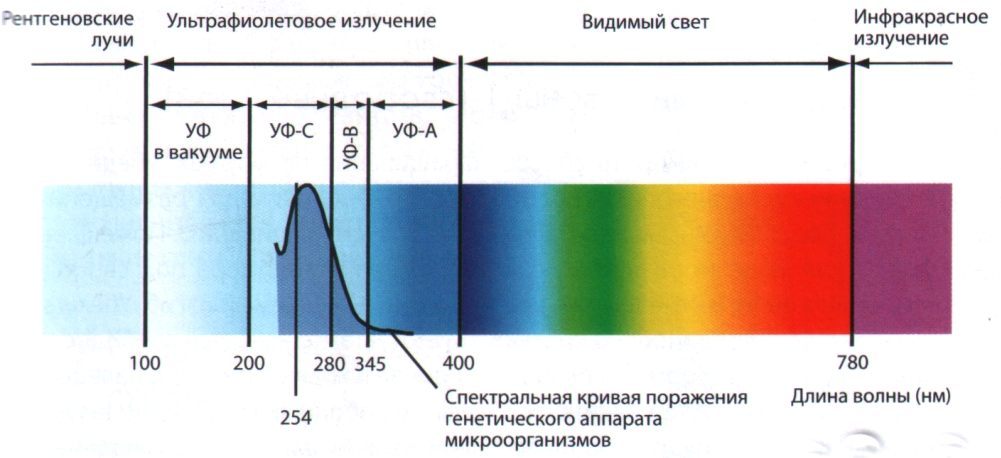
According to the ISO-DIS-21348 standard, ultraviolet radiation is divided into several subtypes (it is noted that abbreviations can be useful when selecting UV LEDs on aliexpress):

All existing sources of ultraviolet radiation (hereinafter UV) can be divided into natural and artificial. The main source of natural UV is the sun. Of the total amount of radiation from the Sun, only its long-wavelength part reaches the earth's surface (~ 3-4% of the total energy of the sun's rays). The shortwave, fortunately (why “fortunately” is described further), is delayed by the atmosphere. Therefore, for the far and extreme UV range, the term “vacuum” (VUV) is often used, meaning that it is impossible to meet it on Earth under normal conditions.
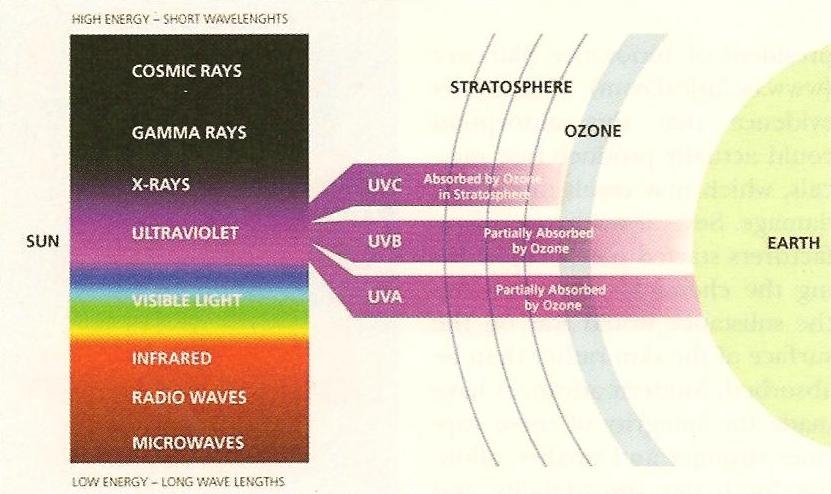
In addition to the sun, a huge number of sources of UV is of artificial, man-made origin. These include laser installations (operating in the UV and “vacuum” UV ranges), electric arc arising during welding, plasma, molten metal and similar objects having a temperature of> 2000 ° C. UV also emit some metallurgical furnaces / blast furnaces for the smelting of high-temperature metals and alloys using oxygen blast, powerful electron and plasma flows, etc. A fairly intense source of UV with a continuous spectrum are electron fluxes of synchrotrons, linear accelerators, and high-power microwave devices. Emit UV and mercury rectifiers - ignitrons (by the way, incredibly beautiful, in my opinion, devices).

But the most common (
They emit UV without exception, the only difference is in the power and proportion of UV radiation relative to other types of radiation. There is a share of UV in the "light bulb Ilyich", which today has practically disappeared from the houses. In its spectrum, UV accounts for less than 0.1% (although the fraction increases with heating of the lamp). It is logical that for various medical and technological applications such a source will not be enough. That is why, for the needs of science and art, most of them use lamps filled with mercury vapor: lamps of high (150¸400 mm Hg) pressure using an arc discharge, and lamps of low (0.01¸1.0 mm of mercury). a) pressure using a smoldering charge. There is truth, however, and lamps of ultrahigh (> 1 atm) pressure, but they are used quite rarely. In flasks of lamps there are mercury vapors (or even drops of metallic mercury, which evaporate when heated), which under the influence of an electric discharge goes into the excited (*) state and begin to radiate intensively in the UV region. The principle of operation is shown onpattern . Functional differences are only in the circuitry of ignition, charge maintenance, etc.
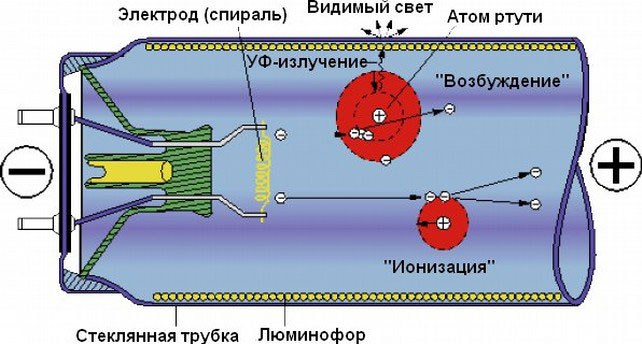
Those. the absolute majority of lamps for various purposes use the same principle. The main functionality of the lamp is realized at the stage of passing UV radiation through the glass of the flask. In the simplest application, it turns out that if the UV passes completely - we get a quartz lamp, the radiation is completely delayed by the phosphor on the walls of the bulb - we get a fluorescent lamp, the radiation is selectively filtered at a certain wavelength - we get some kind of UV lamp for catching mosquitoes .
From the above, it follows that the main component responsible for the range of waves that the lamp emits is the glass envelope (“bulb”) of the lamp, more precisely the chemical composition of the glass from which it is made.
By changing the characteristics of glass, manufacturers achieve the manufacture of devices capable of creating radiation in a strictly specified wavelength range, optimal for certain purposes. For example, when creating germicidal lamps, so-called. Uviol glass (from lat. ultra - outside, on the other side, above and lat. viola - violet color). Its main feature is that upon receipt, the presence of coloring impurities that absorb the ultraviolet of Fe 2 O 3 , Cr 2 O 3, and TiO 2 is minimized . In the so-called "bezosonovye" bactericidal lamps it is used titanium oxide TiO 2which selectively absorbs ultraviolet with a wavelength of 180 nm (this UVC ionizes oxygen with the formation of ozone).
The same principle works for other wavelengths. For example, to create a Wood lamp (“disco UV”) with a transmission maximum in the range of 368–371 nm, a uviol glass bulb is used in a very dark, blue-violet color, which is formed by adding cobalt / nickel oxide (NiO / CoO content around 9%). Instead of violet glass, a phosphor based on europium doped strontium borate (SrB 4 O 7 : Eu 2+ ) can also be used , while lead-doped barium silicate (BaSi 2 O 5 : Pb 2 +).
The picture below shows the standard formulations and the corresponding wavelength.
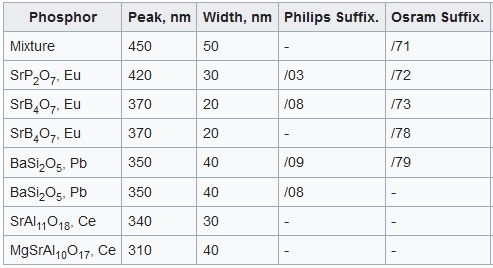
As LED sources, I can act as LEDs (where now without them in the 21st century). The truth is to achieve such a narrowband, as in fluorescent lamps is not yet possible. Most of the existing solutions operate in the wavelength range> 380 nm, and there you can reach 400 nm by hand. Those. on aliexpress for a couple of dollars the maximum that can be bought is the LEDs of a beautiful, but still visible, purple range. Therefore, all sorts of penny "disinfectants" (... water, inhaled air, rooms, keyboards, etc., thousands of them) will not work. The most interesting thing is that in the last 5-7 years there have been exceptions in the world of LEDs that can generate a real, and even hard UV (killing bacteria, also “254 nm”). The picture below shows these semiconductor counterparts. "Mercury lamp" (of course, adjusted for power, but I'm tied to the wavelength), with a net 245 nm, and the cost of some 300 euros (~ 100 conventional UV can be bought for the money).
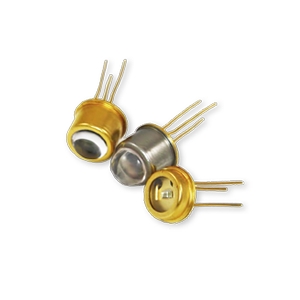
Who does not like the LED for 300 euros, you can try the LED for $ 140.

Sells their hot favorite ThorLabs. True, these are UVC UVC light-emitting diodes (280 nm at the peak), but you should not be upset, since according to the guidelines of the sanitary-epidemiological regulation of the Russian Federation, it is believed that ultraviolet radiation with a wavelength range of 205-315 nm has a bactericidal effect picture at the beginning of the article with the caption "Spectral curve of the defeat of the genetic apparatus of microorganisms").
In general, what can I say. And the fact that due to differences in the production technology of glass (and / or output control) a fluorescent lamp can produce a different wavelength range. The phosphor tends to fade out, shatter, etc. over time. etc. This means that there is a possibility that the cause of a burning sensation in the eyes can be not only increased corneal dryness, but also UV burn (see the section on biological effects). So, reader, support in a friendly way the transition to LED lamps, even if they want to, they are unlikely to squeeze an “adult” UV out of themselves.
Application. Art and science
The most beautiful thing we can experience in life is mystery. It is the source of all true art or science.Writing about the use of UV is difficult, because it is very, very extensive (and as a rule, those who apply, know what they use, and when they do not know, they guess). In the spoiler I will hide references to books in which you can read about it.
Albert Einstein
Мейер А., Зейтц Э. Ультрафиолетовое излучение, пер. с нем., M., 1952 James R. Bolton, Ultraviolet Applications Handbook, Bolton Photosciences, 2010 James R. Bolton, Christine Colton, The Ultraviolet Disinfection Handbook, American Water Works Association, 2008 Larry J. Forney, Carmen I. Moraru, Tatiana Koutchma Ultraviolet Light in Food Technology: Principles and Applications CRC Press, 2009 Ahmad I. Shamim, Ultraviolet Light in Human Health, Diseases and Environment, Springer, 2017
It is important to note that the scope of application , in most cases, linked to a particular frequency range of UV. In its simplest application, it looks like this:
13.5 nm: photolithography in deep ultraviolet 30–200 nm: photoionization, ultraviolet photoelectron spectroscopy (UPS), production of electronic components using photolithography 230–365 nm: UV-ID, tag tracking, barcodes 230-400 nm: optical sensors, various tools 240–280 nm: disinfection, disinfection of surfaces and water (DNA adsorbs UV with a wavelength of 260 nm) 200–400 nm: forensic analysis, determination of drugs 270–360 nm: protein analysis, DNA sequencing, drug detection 280–400 nm: medical cell imaging 300–320 nm: phototherapy in medicine 300–365 nm: curing of polymers and printer inks 350–370 nm: insect traps (most insects are sensitive to UV with a wavelength of 365 nm)
Much more spectacular than any VUV photolithography is the use of UV in areas associated with visualization (i.e., transfer to a format that is accessible to the eye). This possibility is based on the fact that due to the high energy content, UV photons can convert atoms of many organic and inorganic compounds to the excited (*) state and thereby cause the luminescence phenomenon, i.e. non-thermal luminescence (as a rule, in the visible range, which is why all this is so appreciated by our eyes, which are not too sensitive to other ranges).
From the most nice things you can remember, for example, the glow of minerals and rocks. This phenomenon has been known for a long time and is actively used in mineralogy, geology and mining for rapid detection ( suchsmall lamps for this use).
Thanks to the Internet, the amateurs can share their impressions, which they gladly use by posting photos of precious, semi-precious and ornamental stones glowing in the UV rays (topaz, for example, glows bright green, emerald - red, pearls - gives a rainbow picture and .d.) You can read more (and see pictures) here , here and here.
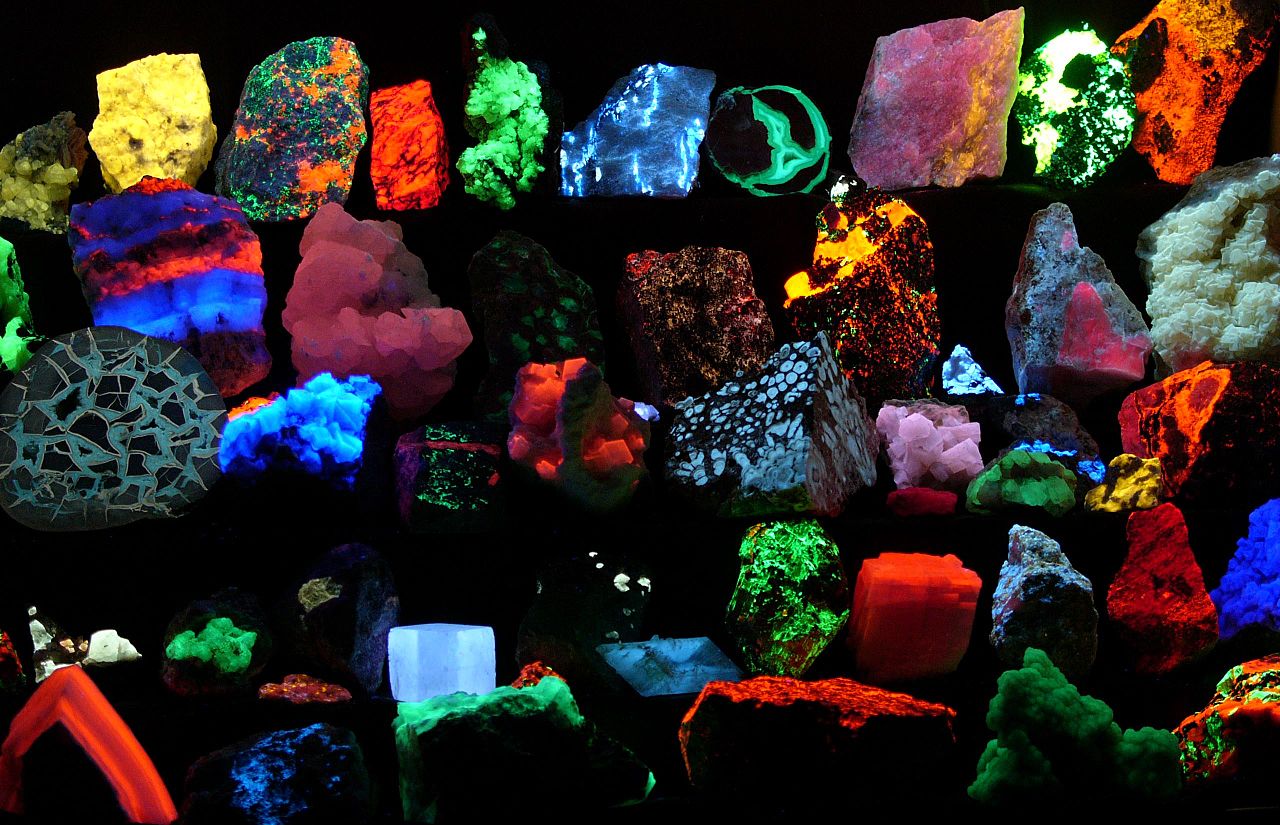
Another great (yes, what a fabulous one is here) is obtained by lighting up the UV with various flowers. There are many complex organic compounds in plants that gladly share their luminescence with the viewer. And since the location of the compounds is completely disordered, the pictures are fantastic. Photographer Craig P. Burrows is actively exploiting this topic in his works :
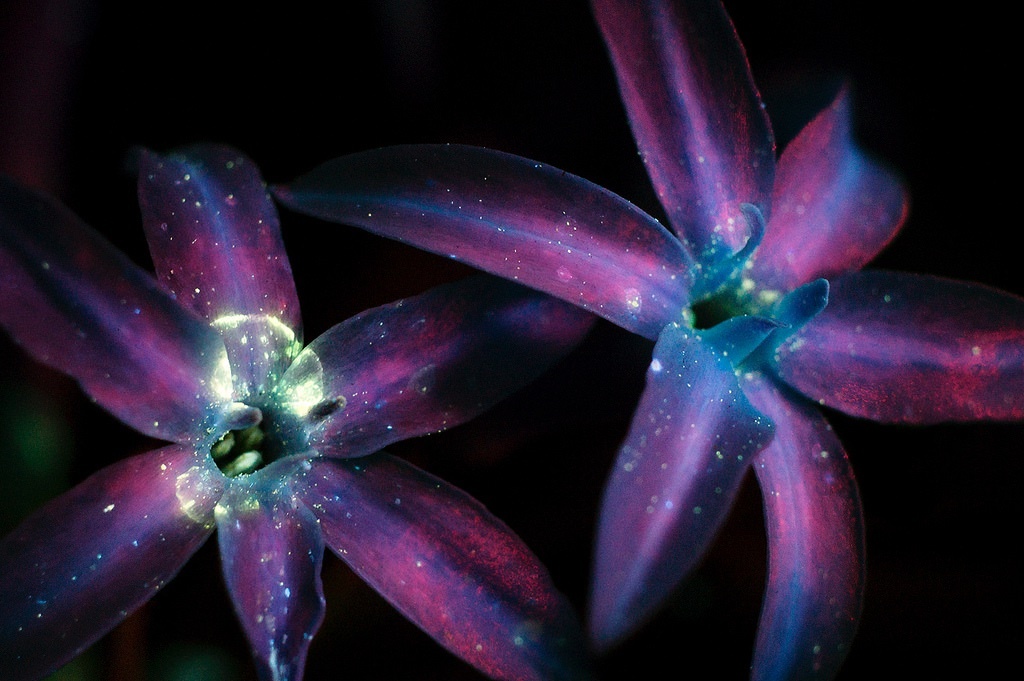
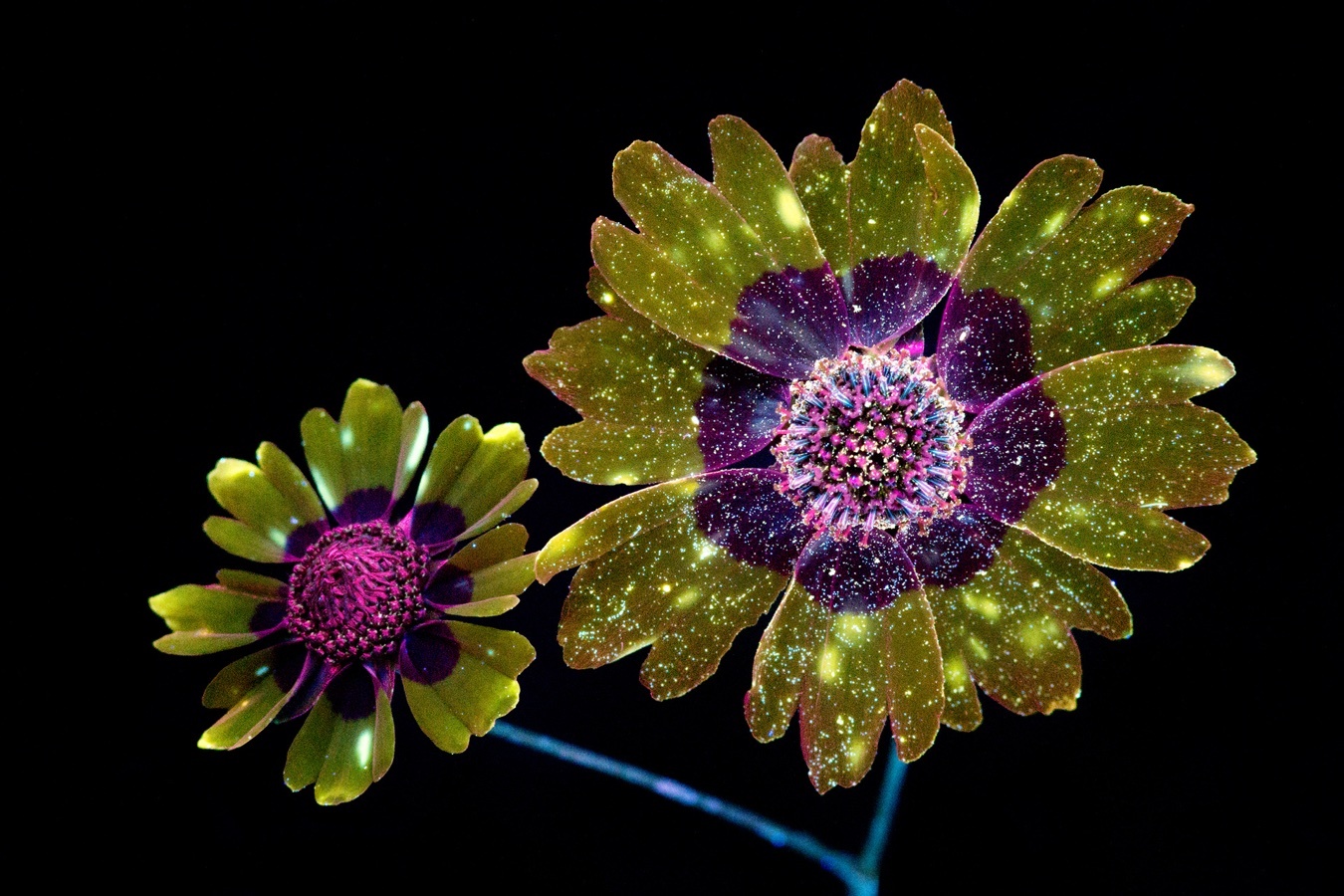
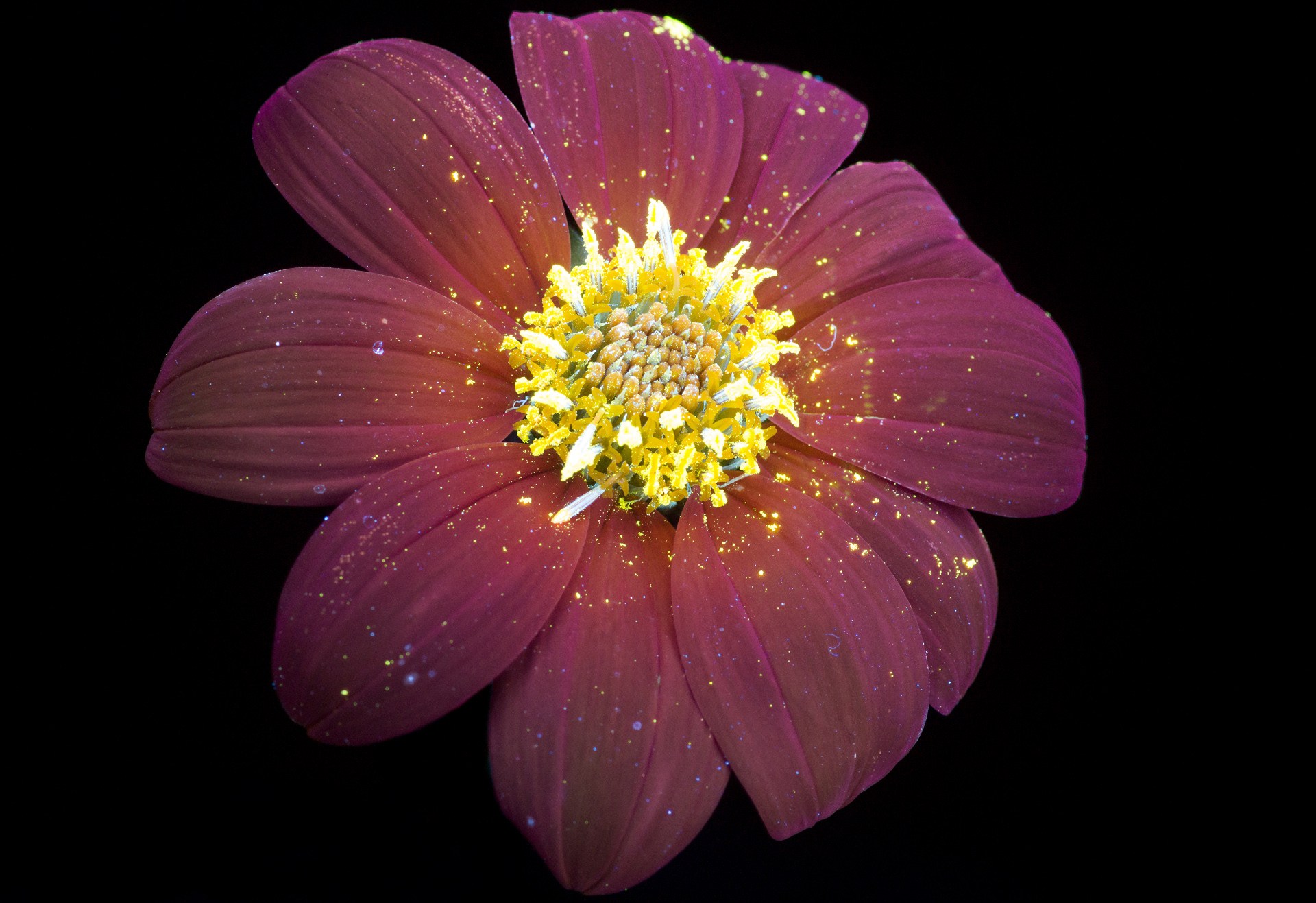
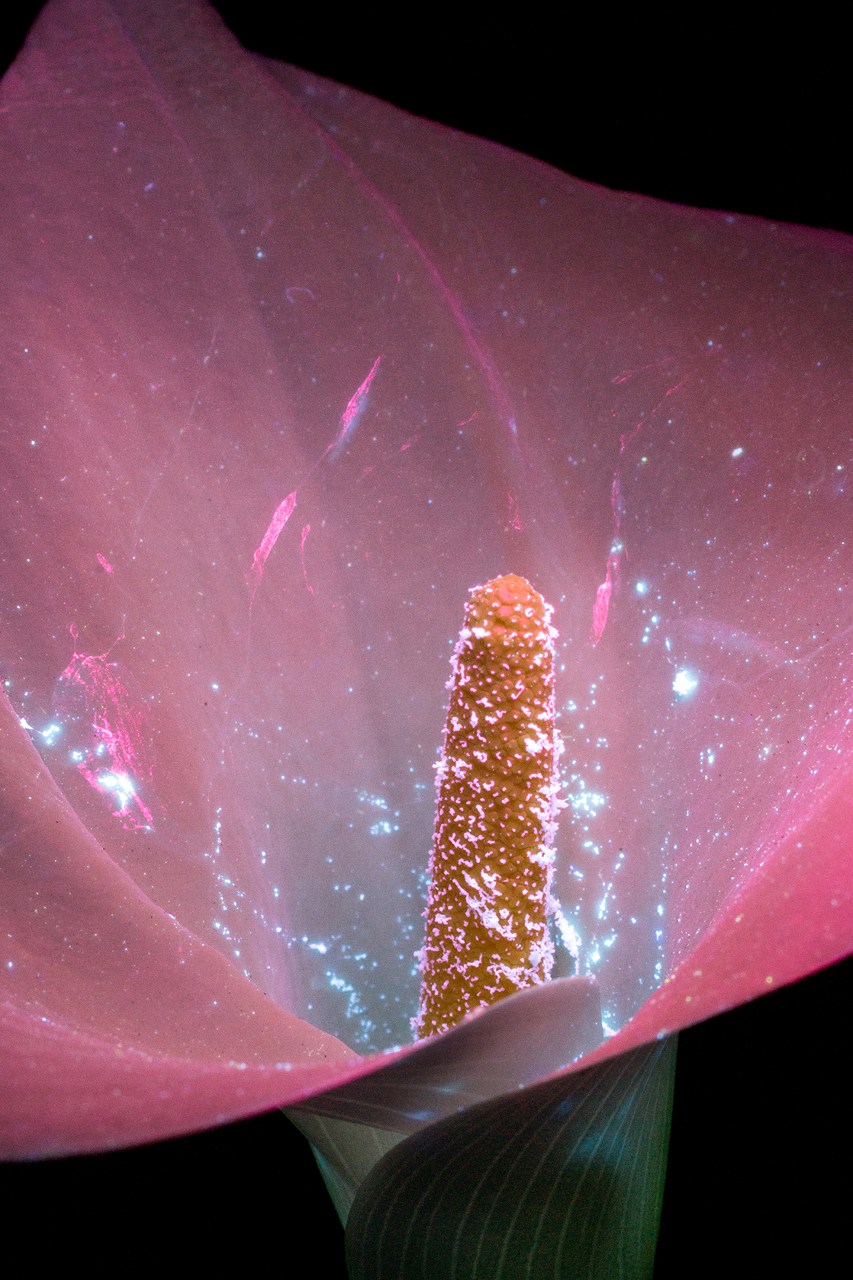
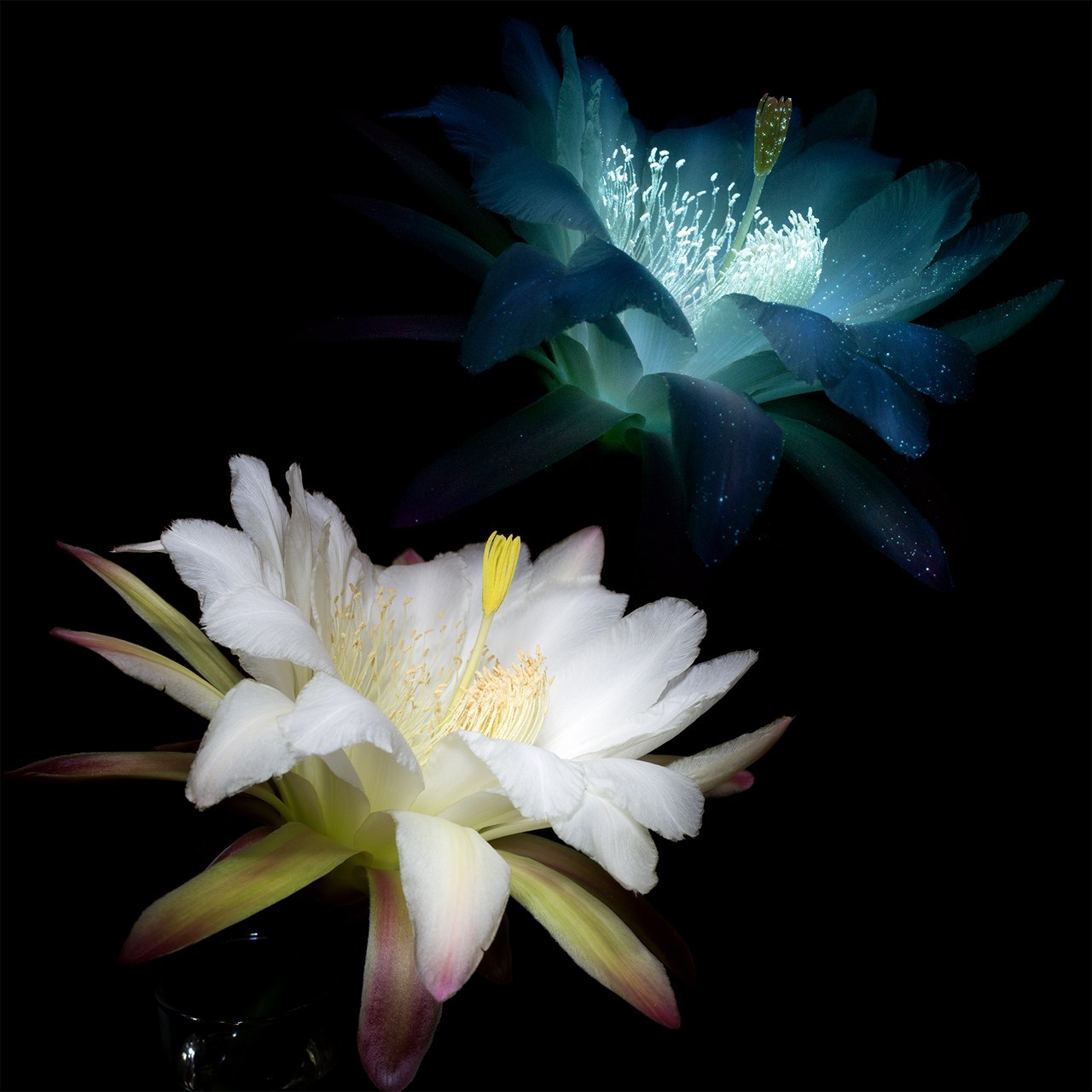
UV luminescence is actively used in cosmetic and similar purposes. On sale you can find a lot of glowing cosmetics and paints for application to the body . Although the “tint” of an insufficiently clean (or weakened) organism can also be bacteria / fungi and other disease causing microflora, which also contains substances capable of luminescence. A rather well-known method of rapid diagnostics called lumdiagnostics or Wood's lamp diagnostics is based on this particular microorganism.. The technology is simple, accessible even to the uninitiated user (with subsequent, naturally attendance to the doctor) and therefore is actively used in dermatology, cosmetology and veterinary medicine, for the rapid determination (moreover, quite accurate) of various pathologies on the skin. The bottom line is that in the UV, in the range of 360-370 nm, many waste products of fungi, bacteria and microparticles of toxins give a clearly visible bright glow of various shades. In order not to be intimidated by the details, I'll hide it under the spoiler.
As follows from the foregoing, UV simply cannot fail to arouse idle interest among a wide range of readers
Biological effects: benefits and harm
About the benefits of UV can probably be able to tell a lot of visitors tanning salons and those who have overcome the lack of vitamin D3 in the body. Actively worked on the promotion of UV as a therapeutic physiotherapy procedure in the USSR, the mandatory UV baths were even introduced into the astronaut's life program outside the Earth. Therefore, just quote Wikipedia ( RU ):
It has been convincingly proven in hundreds of experiments that radiation in the UV region of the spectrum (290-400 nm) increases the tone of the sympathetic-adrenaline system, activates defense mechanisms, increases the level of nonspecific immunity, and also increases the secretion of a number of hormones. Under the influence of UV radiation (UV radiation), histamine and similar substances are formed, which have a vasodilating effect, increase the permeability of skin vessels. Changes in carbohydrate and protein metabolism in the body. The action of optical radiation changes pulmonary ventilation - the frequency and rhythm of breathing; gas exchange, oxygen consumption increases, endocrine system activates. Particularly significant is the role of UV radiation in the formation of vitamin D in the body, which strengthens the musculoskeletal system and has anti-chitin effect. Of particular note is that long-term failure of CFIs can have adverse effects on the human body, called "light starvation." The most frequent manifestation of this disease is a violation of mineral metabolism, reduced immunity, fatigue, etc. Somewhat later, in the works (OG Gazenko, Yu.E. Nefedov, EA Shepelev, S.N. Zaloguev, N.E. Panferova, I.V. Anisimova) the specified specific radiation effect was confirmed in space medicine . Preventive UV irradiation was introduced into the practice of space flight along with the Methodological Guidelines (ME) of 1989 "Preventive ultraviolet irradiation of people (using artificial sources of UV radiation)." Both documents are a reliable base for further improvement of UV prophylaxis.And now about the harm. As I mentioned above, the DNA of bacteria is sensitive to UV in the range of 240-260 nm, so this range is most often used with bactericidal properties. Human DNA, by the way, has a similar sensitivity :). It is just that the bacterium is small, and the person is large. But seriously, UVA and UVB radiation can cause cell damage, leading to their programmed death, not to mention the various free radicals, etc. The picture below shows schematically the scheme of DNA damage by high-energy UV photon. In short, the most common occurrence of thymine bases and their binding to each other in a dimeric structure, which leads to a distortion of the DNA molecule and, accordingly, the loss of some part of the functionality.

In general, the effect of radiation on various organs and tissues is presented quite clearly in the picture. Even to people not familiar with the English language, it will become clear that the eyes take the brunt of themselves upon acquaintance with UV, although the skin also gets it.
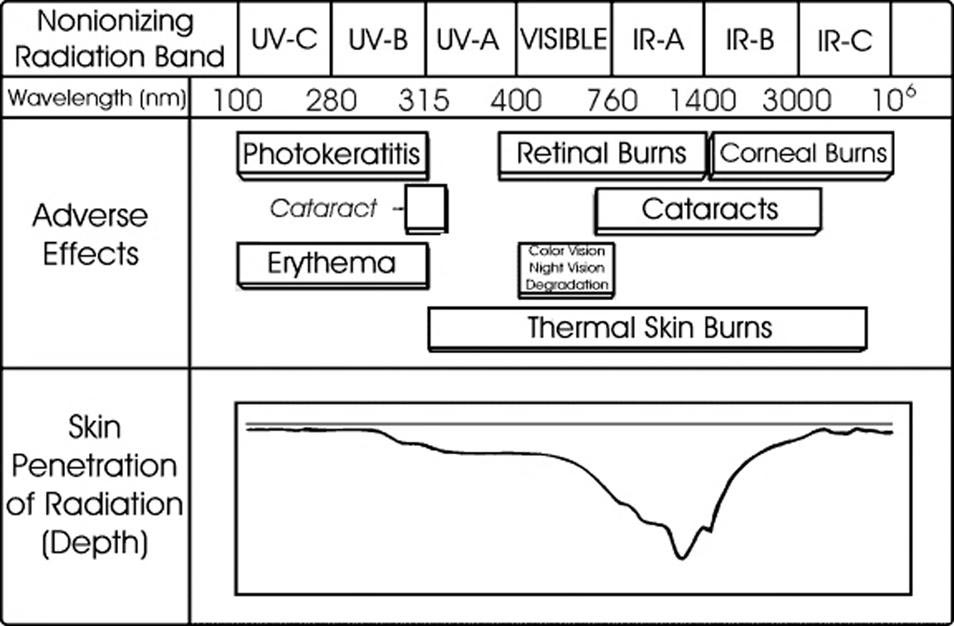
The image below shows a “living” effect of radiation on the skin. It is known that with increasing frequency the photon energy increases, and hence the damaging effect. But at the same time as the frequency increases, the depth of penetration decreases. As a result, the shortwave spectrum (bactericidal) causes severe superficial burns, and the longwave spectrum penetrates deep into the skin, causing damage and mutations in the growth zone. This range is responsible for photo-aging and potential oncology.
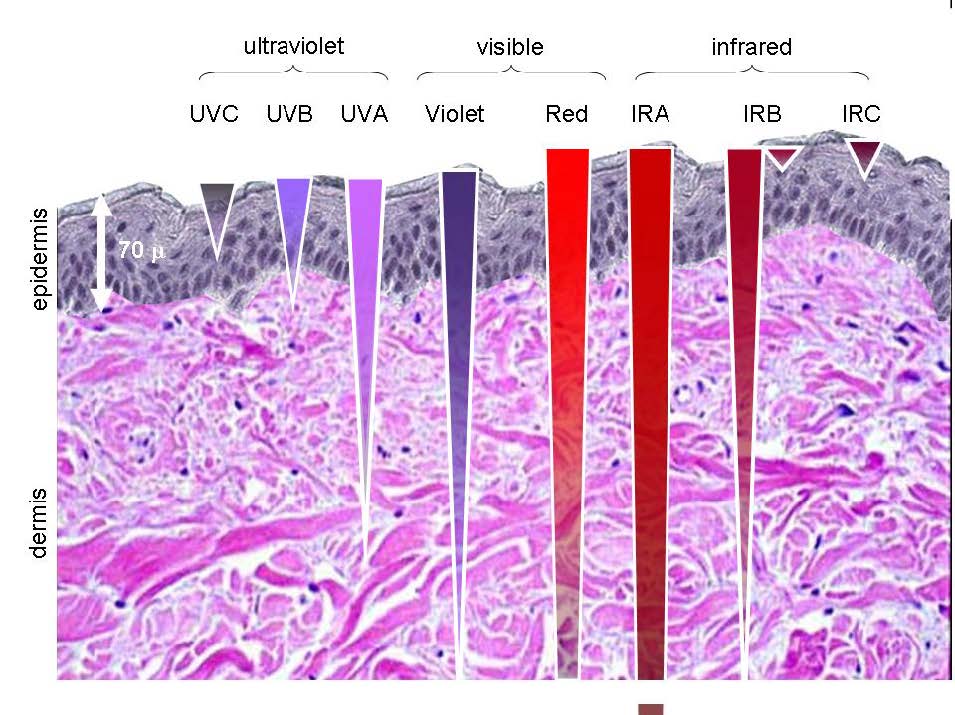
The following picture clearly shows how deeply it penetrates and how well UV is absorbed by various structures and tissues of the eye.
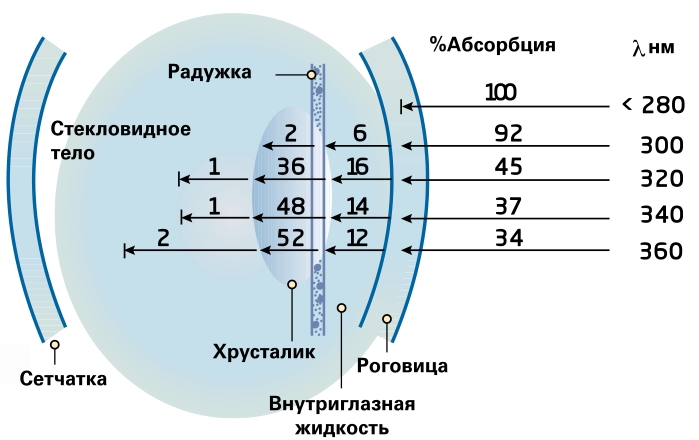
Moreover, it is interesting that with age, the susceptibility of the eye to various types of radiation changes. Under the spoiler - illustrative examples (taken from here ).
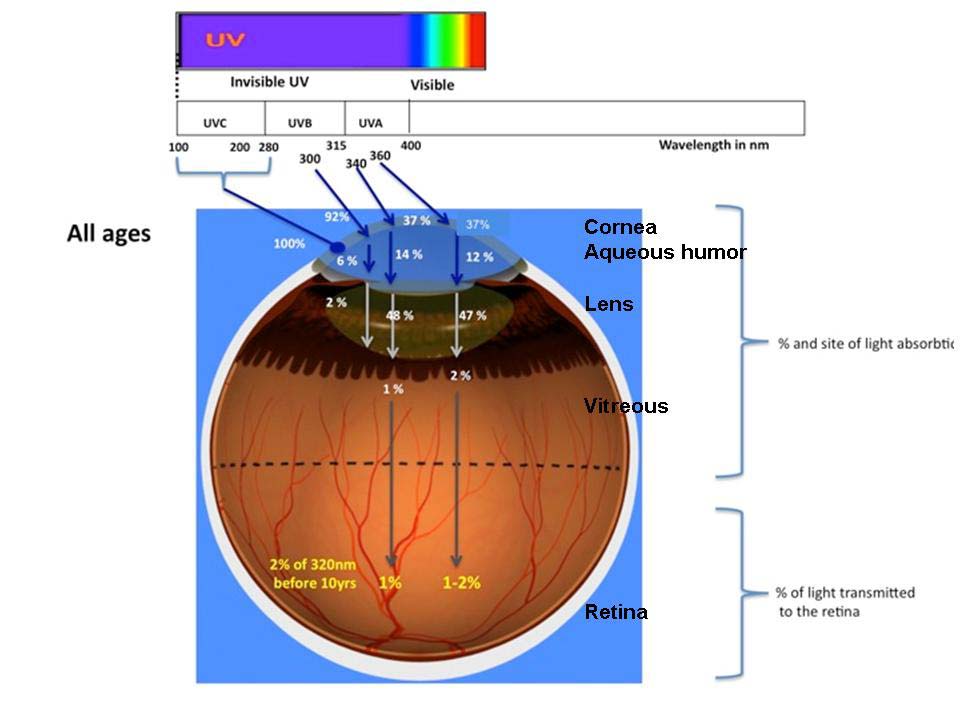
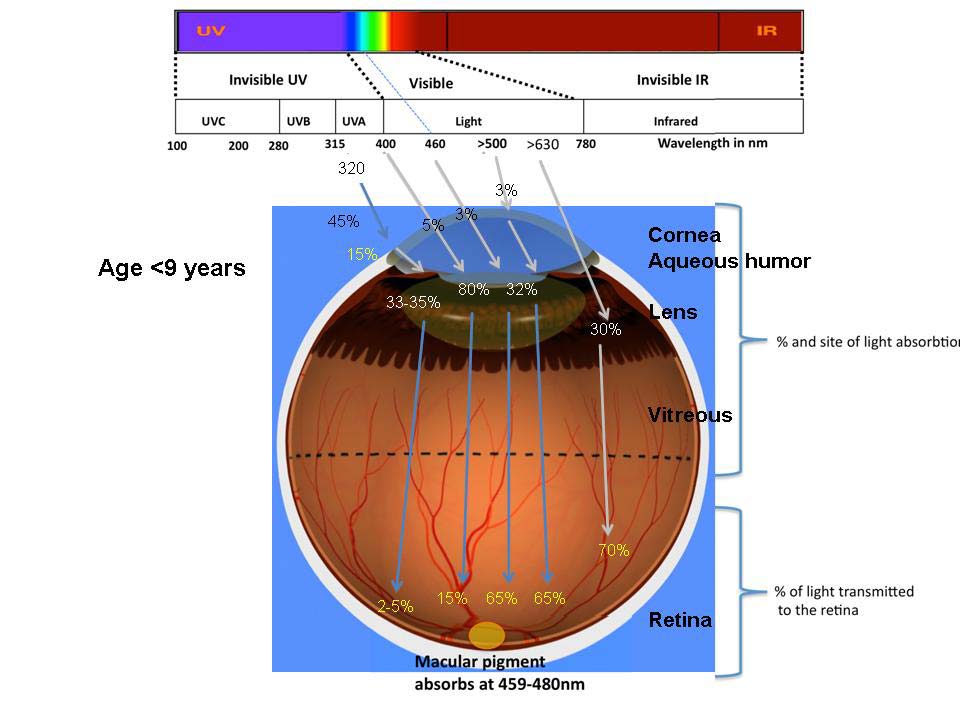
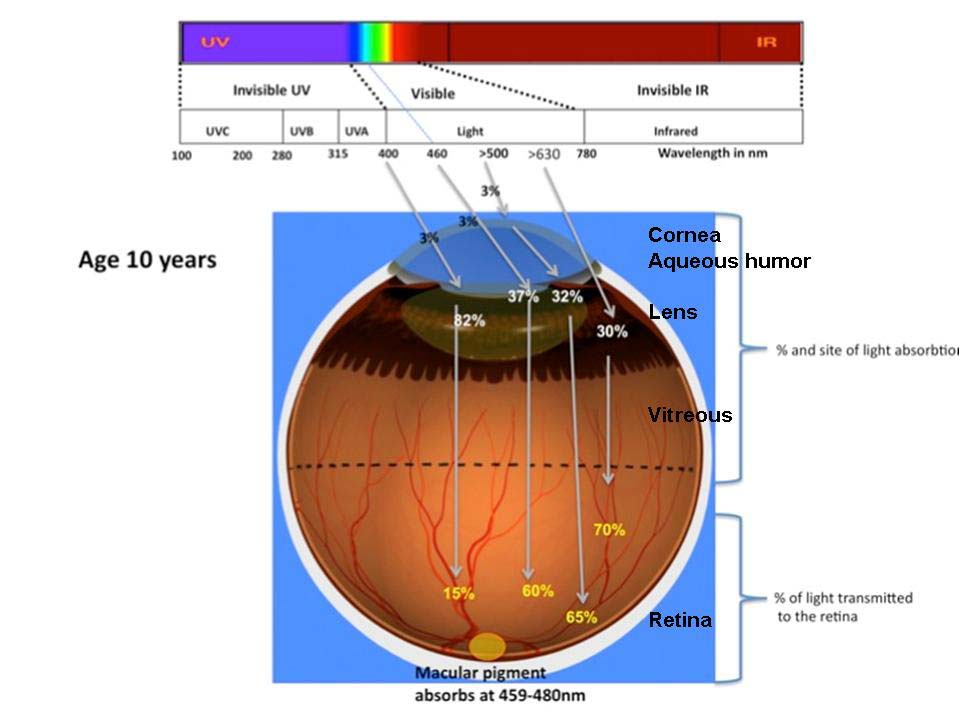
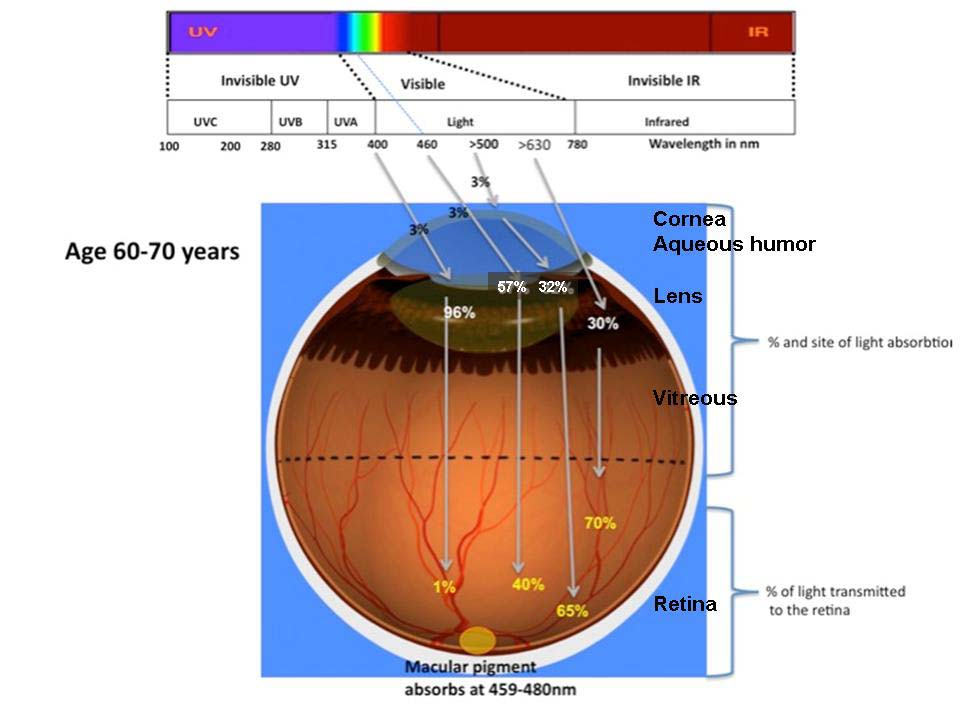
The most common in the modern world - the neighbor, the so-called. “Soft” UV long-wavelength range (315-400 nm). Looking at the scheme, it is clear that this range is almost completely retained by the lens (especially in people of middle and old age). This effect is clearly visible if you look into the eyes of a person while in an institution full of decorative UV lamps.
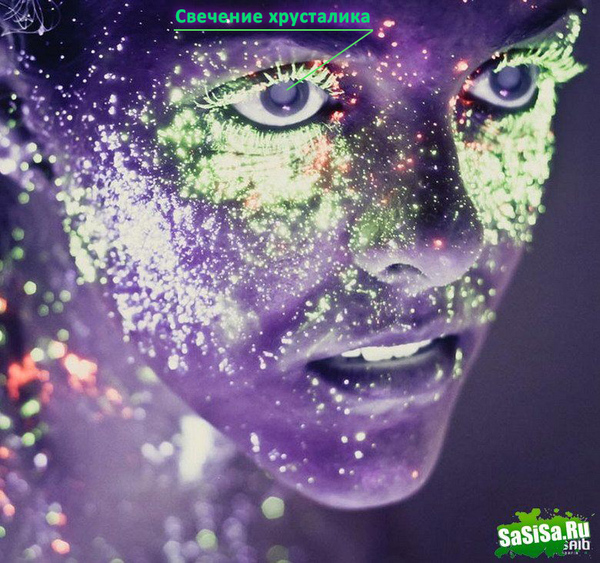
Of course, the intensity of the radiation of such lamps is not too high to cause fatal damage, but, as you know, a drop wears away a stone. Plus, most often, “decorative UV” is used in combination with dimming (lack of lighting) ~ dim light =>
If suddenly it is interesting to someone that it is in the structure of the eye that it reacts / is damaged by a certain wavelength, then a table of correspondences will help. We find our interest further in the ophthalmological dictionary for decoding.
Table - Interaction of light with eye tissues and chromophores (taken from here and translated]
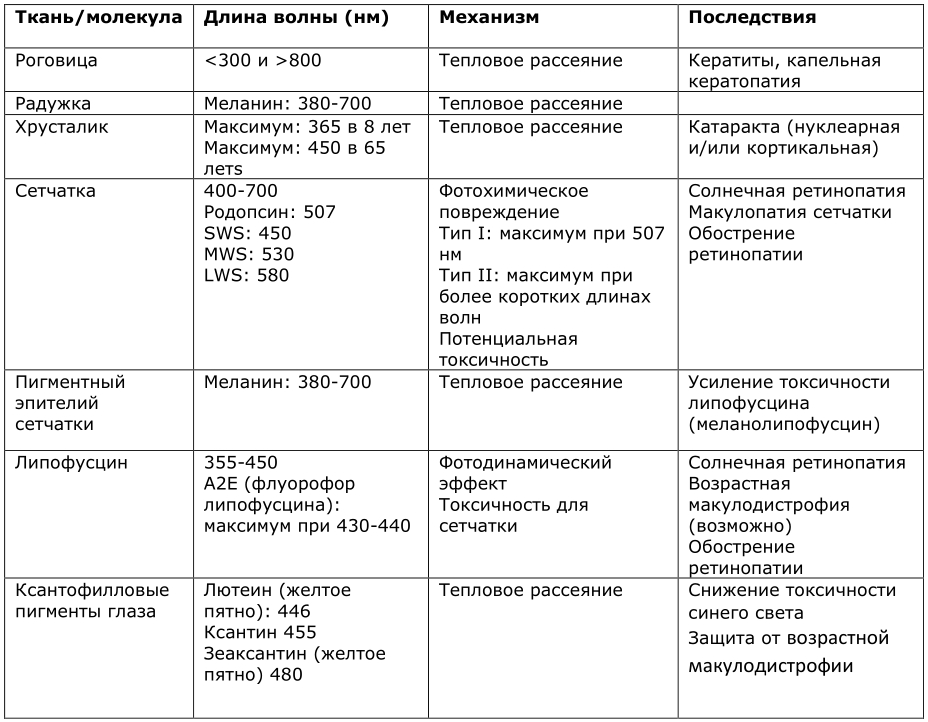
Note: SWS= S-type “cones” are sensitive in the violet-blue (S from the English. Short - short-wave spectrum) part of the spectrum; MWS = M-type “cones” - in the green-yellow (M from the English. Medium - medium wave) part of the spectrum; LWS = “cones” of the L-type - in the yellow-red (L from the English. Long - long-wave) parts of the spectrum.
"What was there? How did you escape? ”- about spectral eye protection from UV
Over the centuries of human existence, people by trial and error have learned with grief in half to defend themselves from solar radiation, someone changing the amount of melanin in the skin and rapidly blackening, and someone using umbrellas and long-haired hats. Heinrich Saulovich Altshullerin its ARIZ-85B, when considering problems, it teaches us to take examples from another technical field, where this problem was solved more successfully. In the case of protection from UV - such areas, in my opinion, can act as mountaineering and welding. From welders you can take note of their dense hb suits and leggings (as far as is permissible, of course). In principle, any sufficiently dense dark fabric perfectly protects exposed skin from UV radiation due to adsorption. But it will be hotter :) and will minimize the risk of multiple reflections (about them below). With the protection of the eyes during welding, everything is also in order, but it’s too ugly (shield and masks look like this ... well ... I think everyone knows what they look like). Better like this:
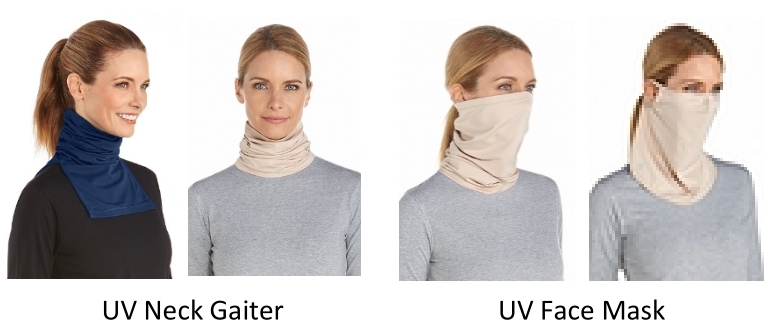
Therefore, when talking about protecting your eyes from UV, it is best to use the mountaineers' equipment. And not only them, by the way. In the technique and practice of mining, the radiation burn of the eye is called the term " snow blindness ".
Snow ophthalmia or snow blindness - a burn of a conjunctiva and a cornea of an eye ultraviolet rays of the sun reflected from snow crystals. Especially often occurs in spring, in the period of "snow shine", when the reflectivity of snow cover increases.Moreover, long before the emergence of mountaineering and mountain tourism, indigenous peoples living in the regions of the Extreme North, in Alaska, etc., came across this phenomenon. And they found their own solution - glasses with narrow slits . With this approach, parasitic illumination (i.e. those reflections) in the eye is completely minimized.
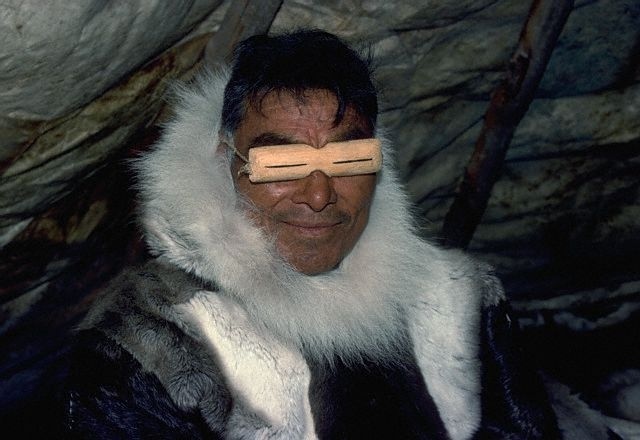
In mountaineering, such glasses were also used (and can be used now, as a reserve, if any Julbo Sherpa suddenly broke ). But of course the convenience and the main visibility does not add such a configuration. This is what V. Shimanovsky advises on this in his famous book Dangers in the Mountains:
To protect the eyes from burns, it is necessary to use protective glasses, whose dark glasses (orange, dark purple, dark green or brown) absorb UV radiation to a great extent and reduce the overall illumination of the area, preventing eye fatigue. It is useful to know that the orange color improves the sense of relief in conditions of snowfall or a little fog, creates the illusion of sunlight. Green color brightens the contrasts between brightly lit and shady areas of the terrain. Since the bright sunlight reflected from the white snow surface has a strong stimulating effect on the nervous system through the eyes, wearing protective glasses with green lenses has a calming effect. It is not recommended to use goggles made of organic glass on mountain and ski travel, since the spectrum of the absorbed part of the ultraviolet rays of such glass is considerably narrower, and some of these rays, which have the shortest wavelength and have the greatest physiological effect, still come to the eyes. Prolonged exposure to this, even a reduced amount of ultraviolet rays, may eventually lead to burns to the eyes.Before going to the materials directly from which the lenses are made, I would like to draw your attention to the fact that the peculiarity of good mountain glasses is that they also protect against side illumination. It is wrong to think that UV gets into the eyes only in a straight line, most of it still accounts for various lateral reflections and reflections. The reflection of UV from the surface, (characterized by the concept of “albedo” - surface reflection coefficient, in the UV range - see the table under the spoiler “Tendency of various materials to reflect UV”) in my opinion is a very underestimated source of radiation. Under the spoiler there is a large informative picture that will help to understand it, using the example of solar UV, although anybody can be reflected.
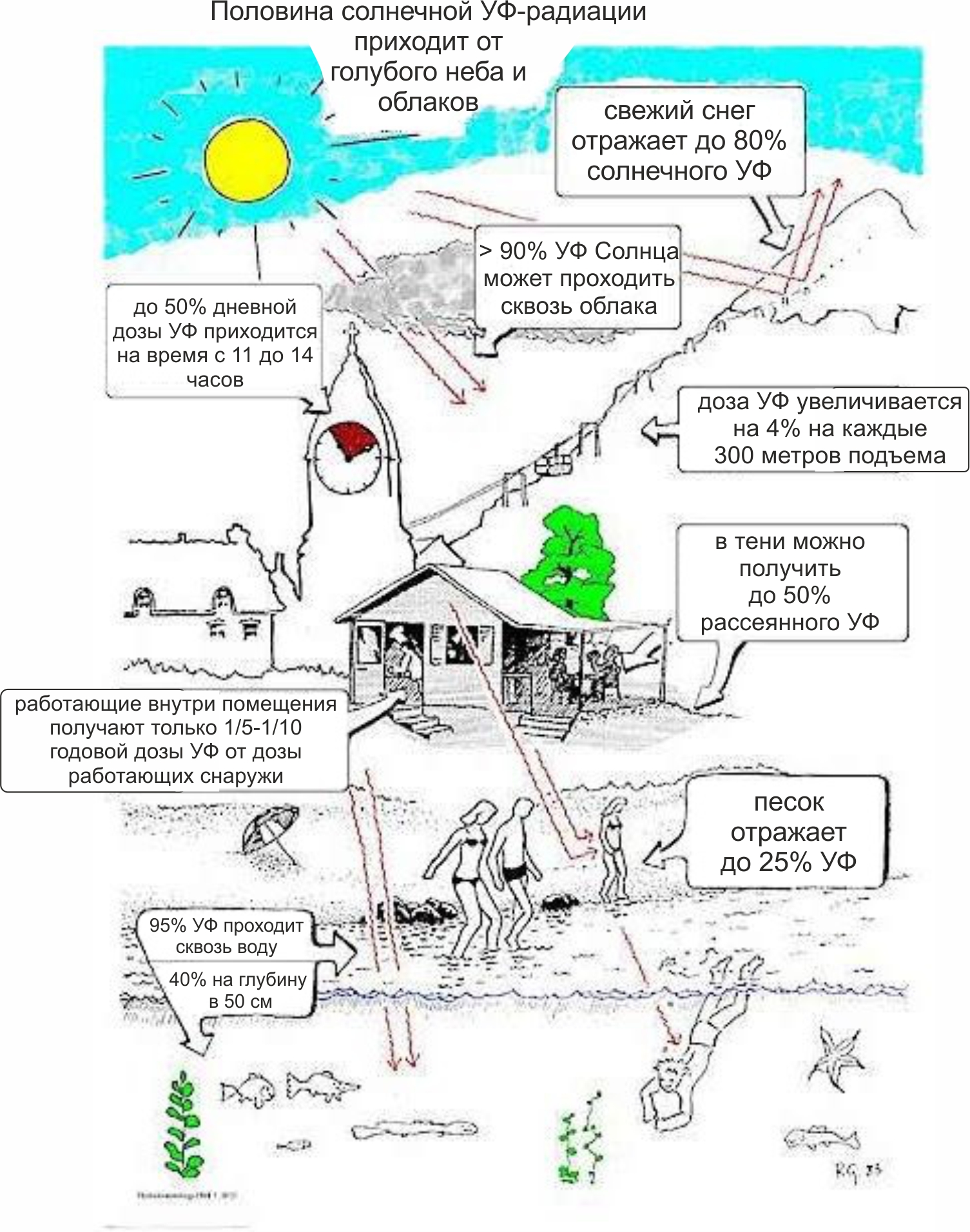
In principle, in the modern city, with its abundance of mirror surfaces and glossy building materials, the situation with the reflections is not much better than in the mountains. Under the spoiler, just in case, there is a plate of reflection indicators for different materials (incidentally, snow is in the lead):
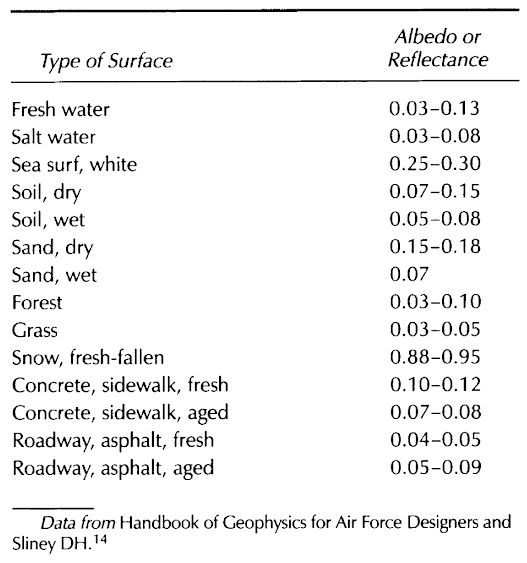
And how it all gets into the eye, bypassing the glasses, you can see under the spoiler. The moral is - glasses should fit snugly to the face (this is observed more often in the so-called " rifle tactical glasses, " about the alp-silence, since they are expensive). Various “fashionable” and fussy modifications are most often simply useless at least because of a non-ergonomic design.
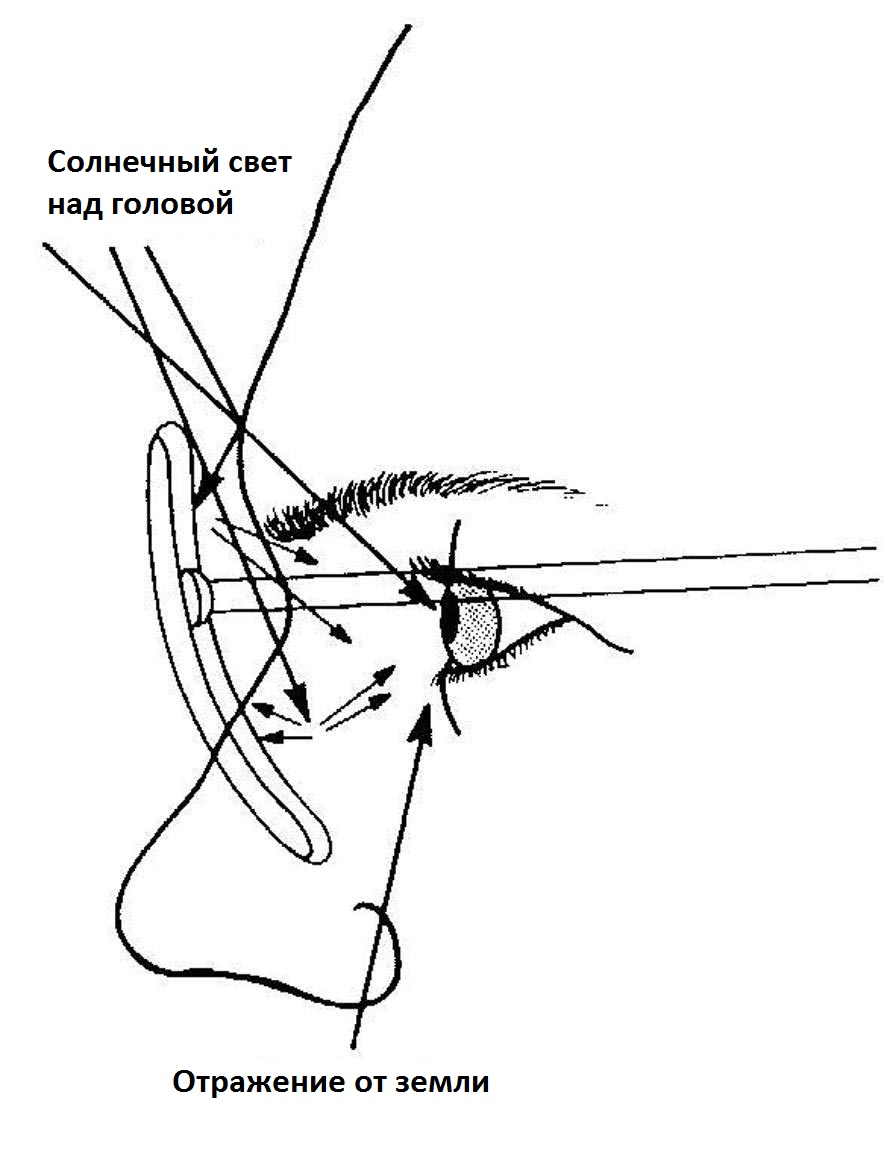
Now about the materials from which the points are made. As mentioned in the chapter on the classification of UV sources, the main thing that makes any fluorescent lamp a UV lamp is the glass from which the bulb is made. The same statement applies to points. In fact, glasses are a common optical filter. In theory, filters for UV can be solid, liquid and gaseous. Naturally, for use as a basis for the lenses of glasses can be used either glass or some of the polymers. Below is a picture from the journal Chemistry and Life (1982, No. 7, pp. 47–51) which quite clearly illustrates the filtering ability of various materials with respect to UV
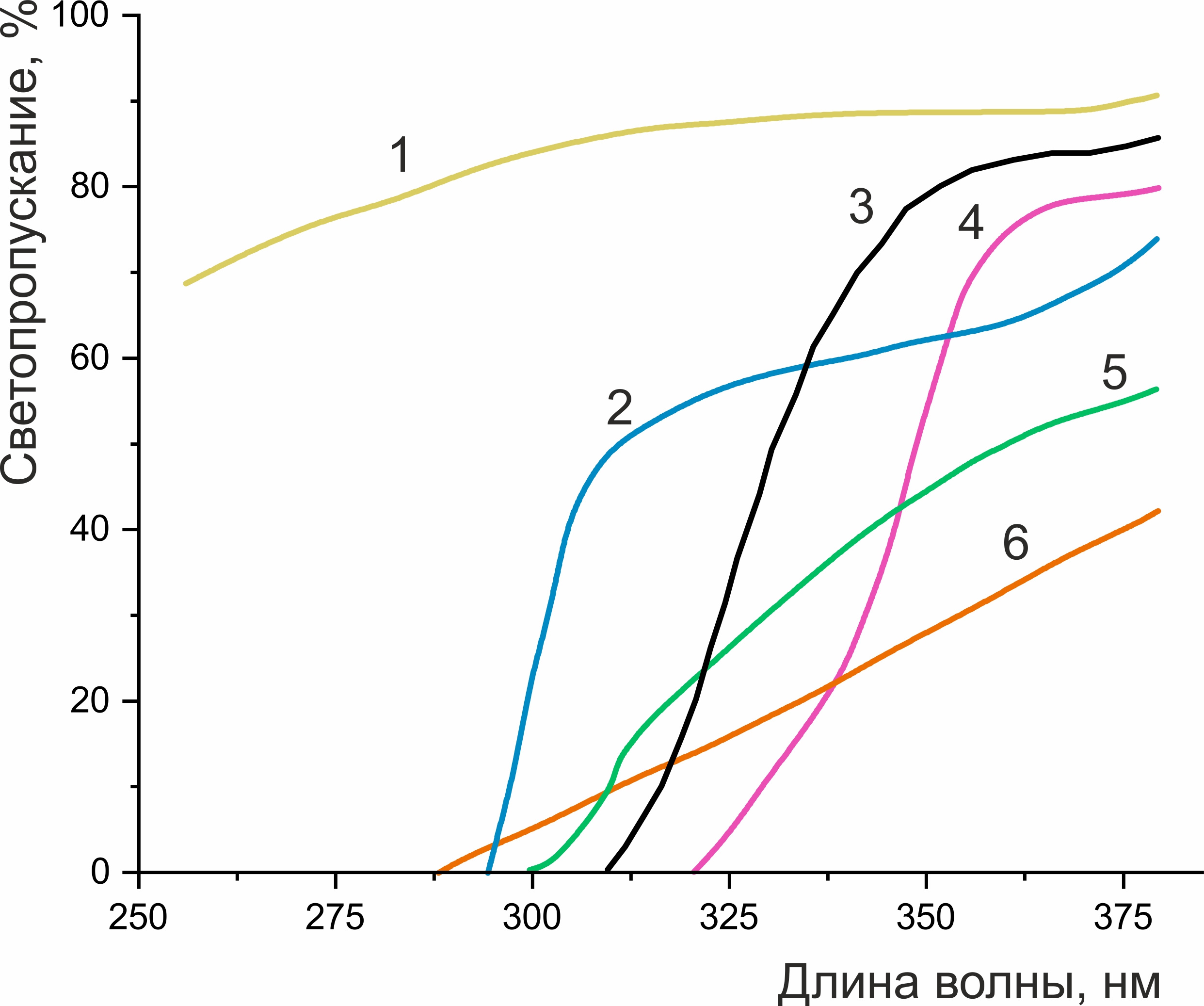
Note: 1-optical quartz 3 mm; 2- 2.5 mm plexiglass; 3 - window glass 1 mm; 4 - window glass 5 mm; 5 - polyester film of 0.15 mm; 6 - polyvinyl chloride film 0.15 mm
From the graph it follows that common materials (almost all) can filter short-wave UV. But shortwave UV is quite rare in our area, only in hospitals, and when working with UV-erasable memory chips (and these now still need to be found). Polycarbonate (PC), which is widely used for creating glasses, is absent on the graph, but nevertheless, without additional sprays, it perfectly passes UV up to 300-350 nm. And how to find out if there is sputtering there or not (especially in the case of glasses purchased on Aliexpress) - I will try to explain further.
In general, if the sellers say that the glasses do not let the UV through - they most likely are not being cunning, but I hope I have quite clearly explained why it is important to clarify WHICH THE UV does not miss the glasses. There are many ranges, the prevalence in the world around is different. On the beach, glasses that delay "bactericidal", but miss the long-wave - will bring harm. At one time, the UV400 badge was a rather convincing argument for buying points.which confirmed that the lens used in glasses protects against all rays with a wavelength less than 400 nm (and this is just the ultraviolet range). Another 95% UV badge can be found, which means that the lenses absorb 95% of UV rays. The Chinese joyfully stamp these badges wherever they can, demand creates supply. A few manufacturers can offer a certificate of quality, where it will be stated that the lens really delays such and such a range.
If we are already talking about plastic "fake" sunglasses (which parents often buy for their children in the nearest stall), then I would like to point out the following thing. As I already mentioned, in bright light our pupil automatically shrinks, helping the lens to protect the internal structures of the eye from UV exposure. And in dark glasses with poor-quality lenses, the pupil “works falsely” and expands, allowing an excess dose of radiation to pass through. So it’s better to do without cheap sunglasses at all by closing off some Afghani from the sun ...
By the way, a small addition. As can be seen from the graphs depicting the spectrum of sunlight, blue-violet, blue and blue waves (400-500 nm) are adjacent to the UV, which can also have a detrimental effect on the structures of the eye, although to a lesser extent (see plate "The interaction of light with the tissues of the eye and chromophores"). Therefore, from the point of view of spectral protection, the most optimal are those glasses whose transmission range of 400-500 nm is 2-3 times lower than the transmission of the green-yellow-orange components (500-630 nm). Those. “jolly” yellow / orange / brown than blue / green / purple will be much healthier.
And what follows from all this?
What follows is that thanks to our vision we get 90% of the information about the world around us. This is, in principle, the most important of our "sensors of the world." And it just needs to be treated as carefully as possible. In summer wear wide-brimmed hats, use normal (see above) safety glasses when working with UV light and constantly check sunglasses for their protective properties.
The easiest option is to adhere to (= search on the manufacturer’s website) safety standards, in particular, American ANSI Z80.3-1986 (in which UV-protected glasses must have the prefix U and some digital index, from 2 min to 6 max). There are the same parameters for Germany (DIN), Great Britain (BS), Australia-New Zealand (AS / NZS 1067: 2003), common for the EU (EN 1836: 2005). For example, compliance with the European standard (as one of the most stringent) is indicated on glasses as CE (Conformite Europeenne) + number from 0 to 4 ( proof ). According to this standard, 5 types of lenses are distinguished, depending on their light transmission ability. 0 - almost does not protect against the harmful effects of ultraviolet radiation, 4 - gives maximum protection.

Let the thing (especially the child) be more expensive, the children will grow up and will say thanks for it, if not with words, so with their deeds and achievements. Minus - in cost.
The option is more difficult - to test meticulously
Началось все с тех самых ламп для отверждения лака на ногтях. Консультанты, которые их продают совершенно не в теме, почему есть два вида ламп с буквой L и без буквы L на конце — UV-9W и UV-9W-L. Мотивируют тем, что для каждого вида прибора (маникюрная «штучка» эта уже стала прибором) — нужна своя лампа. Я прибора такого не имел, подключил в стандартную телескопическую настольную лампу. Ничего не заработало и пришлось разбираться. Оказывается все достаточно просто. В лампе в буквой L установлен балласт в виде обычной лампы неонки (такую лампу можно подключать в настольную лампу), без буквы L — лампа имеет внутри припаянный конденсатор и требует ЭПРА для запуска. ЭПРА без проблем добывается из КЛЛ (на 9~12 ватт) в 90% случаев их неисправность связана с обрывом нити накала, а не с неисправной электроникой…
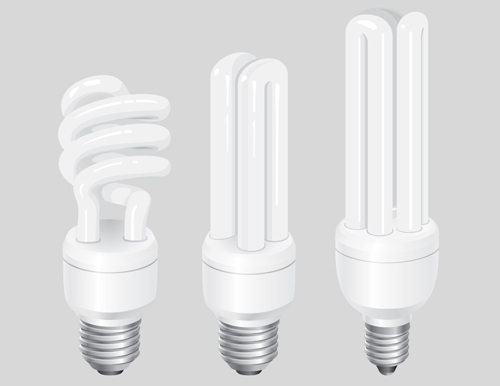
Отпаиваем контакты лампы от разьема и припаиваем к ЭПРА близкой мощности. Все работает, но для таких манипуляций лучше подходят лампы с цоколем G5/2G11/G13 где на разъем уже выведены все контакты от нитей накаливания.
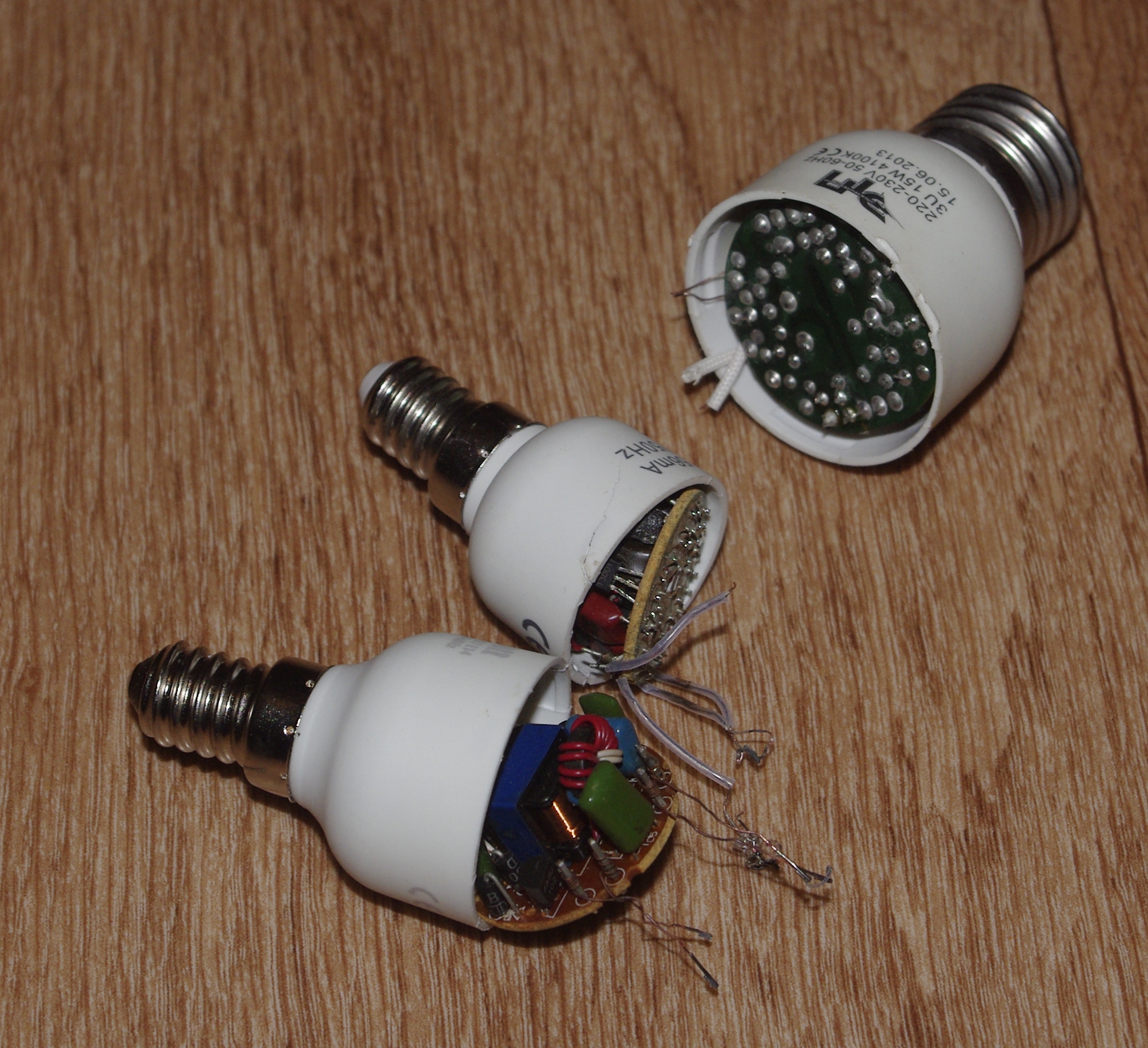
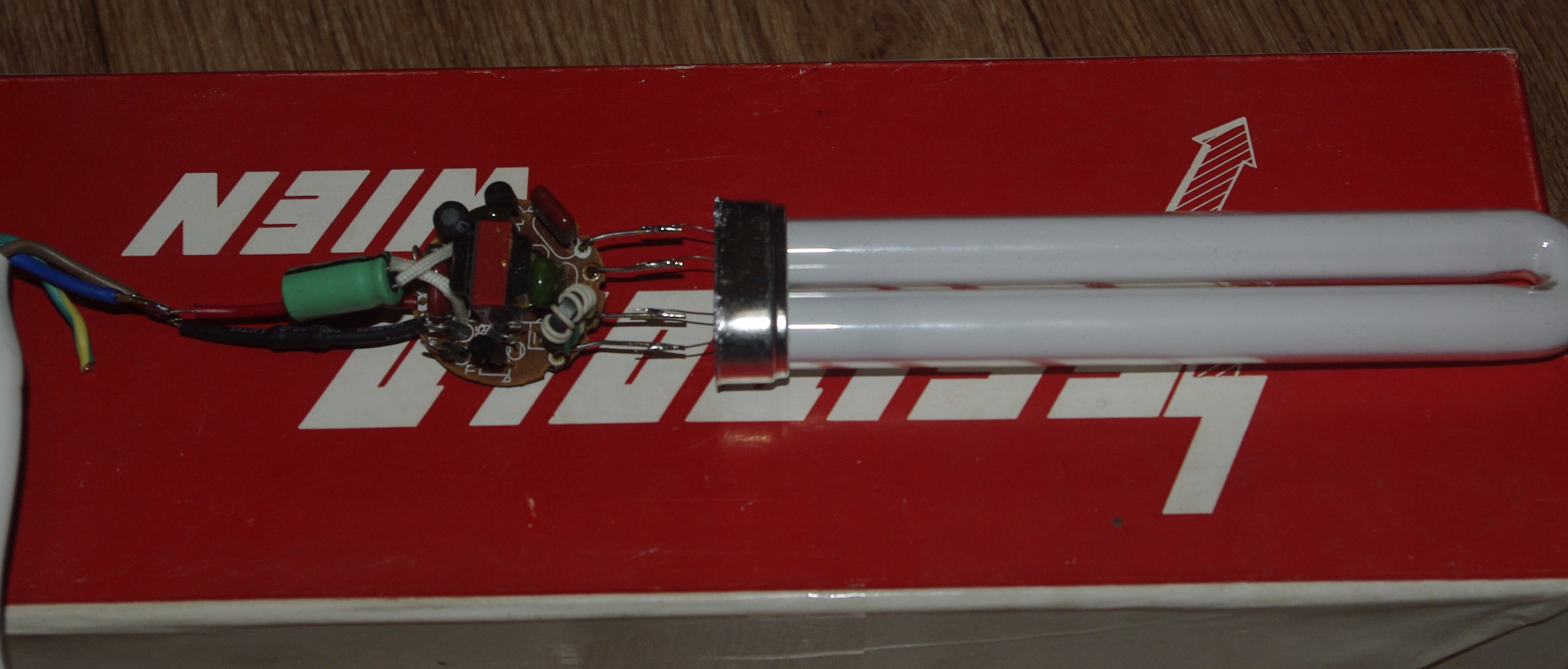
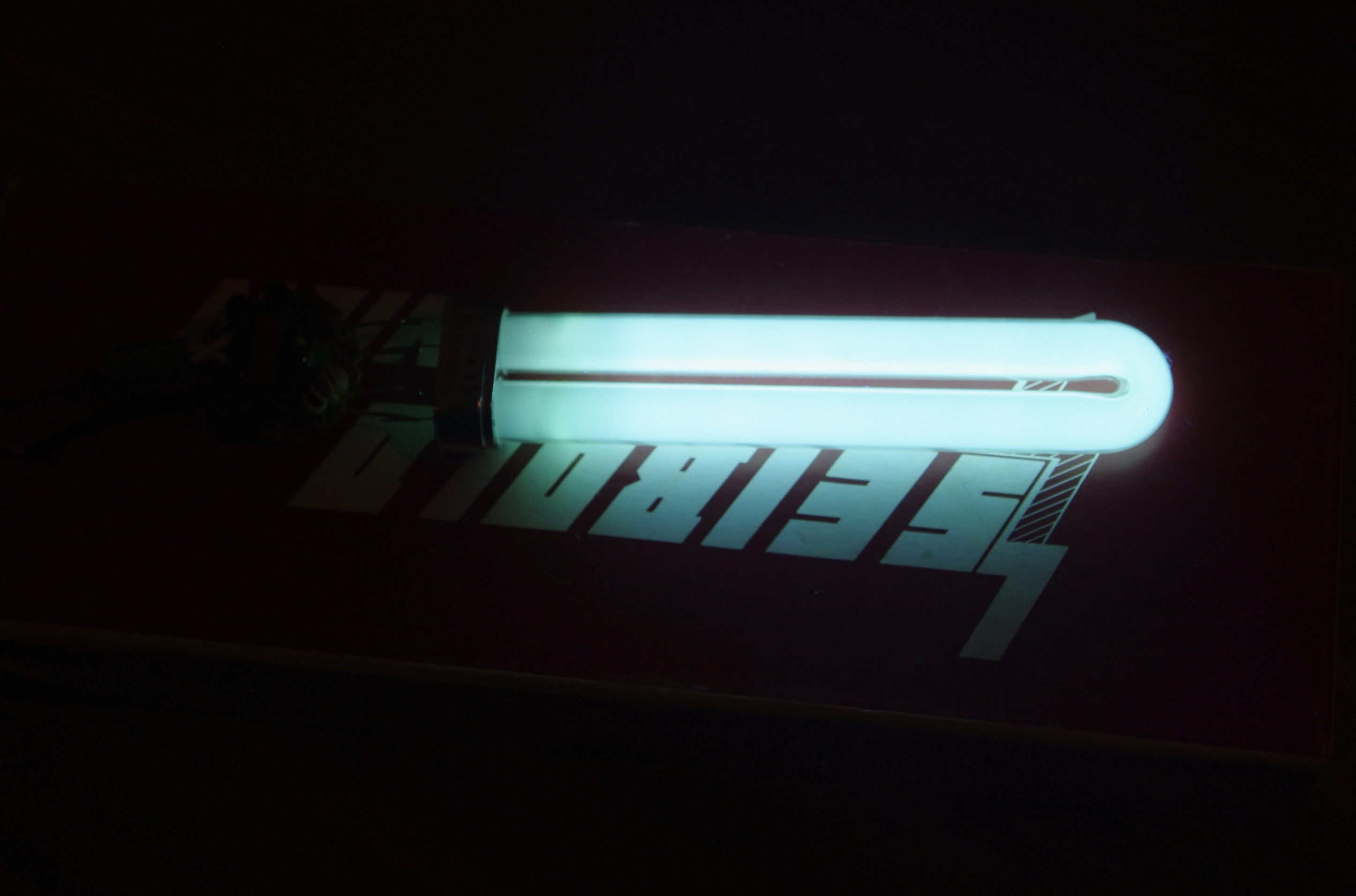
In addition to the lamp, you will need any fluorescent UV mark (a smear of "glowing" lipstick or foundation in the end). By the way, the LEDs used in modern lighting lamps can also act as indicators. For example, noname LEDs with damaged electronics in UV rays.
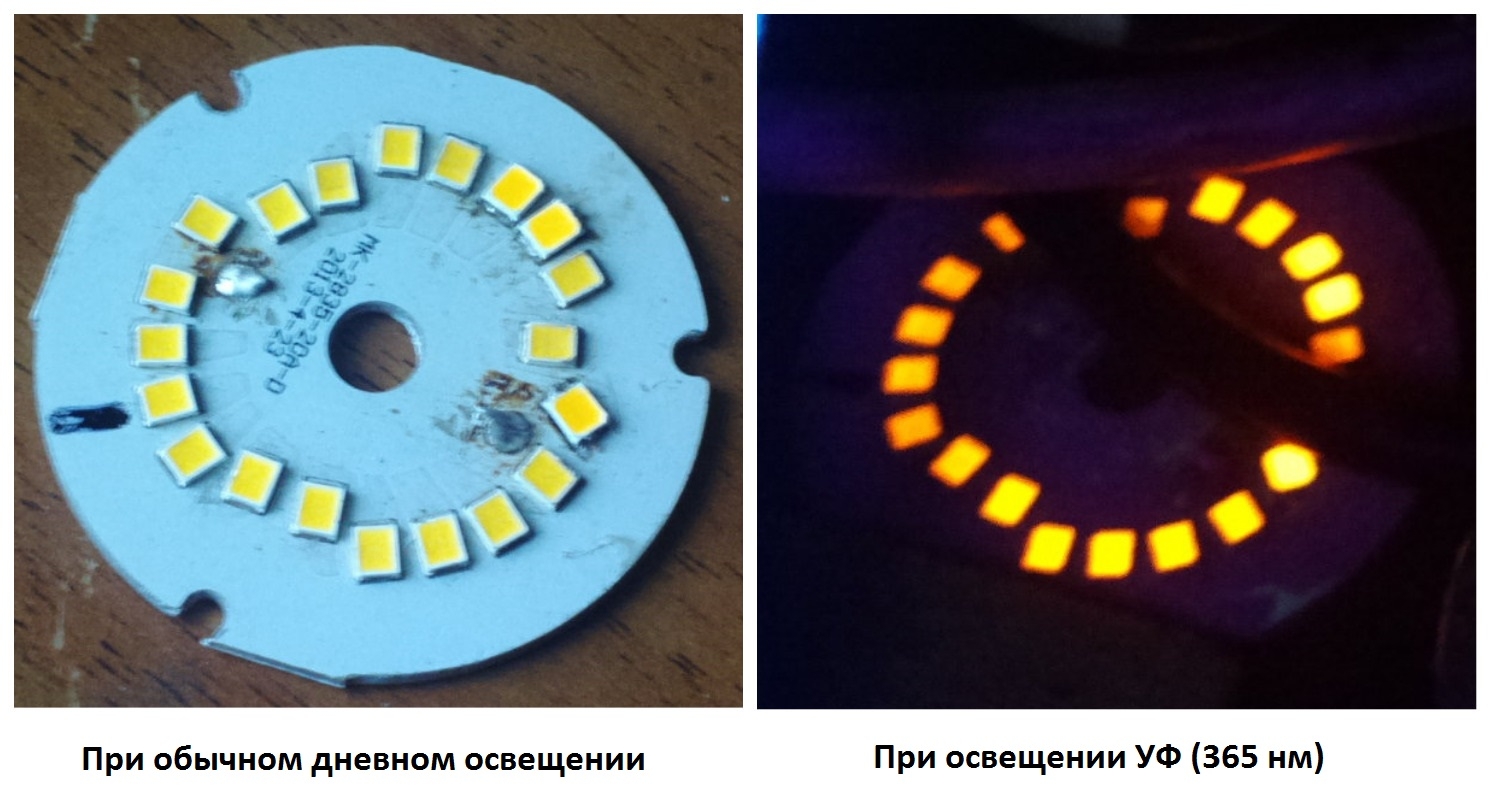
UPD: The varnav user reasonably noticed that a dollar bill can also act as a label. And user zuek suggests to make an indicator from washing powder:
Modern washing powders "with optical bleach" - the most affordable and very high quality "label." All cashiers who work with cash need to know about it - a bill involuntarily washed in a UV detector is very cheerful and evenly lit ...
For detection it is convenient to take an “unbleached” paper strip and wet it with a solution of such powder - there will be a control zone and a work zone - if the difference is visible, it means UV is present.
So, we put the available improvised UV sensor under the glasses and illuminate the UV glasses. Watching:

The label is lit - glasses do not fit. And so - until a satisfactory result is obtained (it may well turn out that after 10-15 such experiments, it will be easier to give hard $$$ for high-quality UVEX / 3M, etc.).
On this all, take care of your eyes, yours and loved ones!
Sergey Besarab ( Siarhei V. Besarab )
Acknowledgments : the author is grateful to his wife - a source of inspiration and search interest in fluorescent UV lamps :)
Photoprotection of the eye – UV radiation and sunglasses
How Light Reaches the Eye and Its Components
Natural UV‐B radiation received by people with outdoor, indoor, and mixed occupations and UV‐B treatment of psoriasis
https://www.researchgate.net/publication/16798031_Clinical_Climatology
Photoprotection
